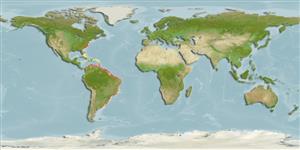Issue
A more detailed taxonomic review of the Eastern versus Western Atlantic M. hypostoma populations is needed to elucidate whether there are population-level differences, or if those differences simply reflect the low sample size available.
Environment: milieu / climate zone / kisaran kedalaman / distribution range
Ekologi
laut pelagic-neritic; kisaran kedalaman 0 - 100 m (Ref. 106604). Tropical; 41°N - 40°S, 80°W - 29°W
Western and eastern Atlantic.
Size / Weight / umur
Kematangan: Lm ? range ? - ? cm
Max length : 230 cm WD jantan/; (Ref. 126011); Berat maksimum terpublikasi: 115.9 kg (Ref. 126011)
Cephalic fins smaller, tail longer without spine (Ref. 7251). Upper surface black (Ref. 6902).
Body shape (shape guide): other.
Occurs in shallow coastal waters (Ref. 12951). Feeds mainly on planktonic crustaceans but may take small schooling fishes (Ref. 12951). Ovoviviparous (Ref. 50449). Found singly, in small groups, and in schools (Ref. 12951). Swimming at high speed and often leap high above the surface (Ref. 6902). Feeds mainly on planktonic crustaceans, but also on small schooling fishes (Ref. 114953). Meat used for food and a source of oil (Ref. 6902).
Life cycle and mating behavior
Kematangan | Reproduksi, perkembang biakan | Pemijahan | telur-telur | Fecundity | Larva
Exhibit ovoviparity (aplacental viviparity), with embryos feeding initially on yolk, then receiving additional nourishment from the mother by indirect absorption of uterine fluid enriched with mucus, fat or protein through specialised structures (Ref. 50449). Copulation has been observed to be in a venter to venter position while the pair swims at the surface. Mating reported to last 10 minutes. Litter number 1 (Ref. 12951).
White, W.T., S. Corrigan, L. Yang, A.C. Henderson, A.L. Bazinet, D.L. Swofford and G.J.P. Naylor, 2018. Phylogeny of the manta and devilrays (Chondrichthyes: Mobulidae), with an updated taxonomic arrangement for the family. Zool. J. of the Linn. Soc., 20:1-26; figs. (Ref. 115945)
Status IUCN Red List (Ref. 130435: Version 2025-1)
ancaman kepada manusia
Harmless
penggunaan manusia
Perikanan: nilai komersial kecil
Alat, peralatan
laporan khas
muat turun XML
Sumber internet
Estimates based on models
Preferred temperature (Acuan
123201): 13.7 - 27.7, mean 23.2 °C (based on 232 cells).
Phylogenetic diversity index (Acuan
82804): PD
50 = 0.5039 [Uniqueness, from 0.5 = low to 2.0 = high].
Bayesian length-weight: a=0.01000 (0.00244 - 0.04107), b=3.04 (2.81 - 3.27), in cm total length, based on all LWR estimates for this body shape (Ref.
93245).
Trophic level (Acuan
69278): 3.8 ±0.59 se; based on food items.
Daya lenting (Acuan
120179): sangat rendah, Waktu penggandaan populasi minimum lebih dari 14 tahun (Fec=1).
Fishing Vulnerability (Ref.
59153): Very high vulnerability (84 of 100).
🛈
